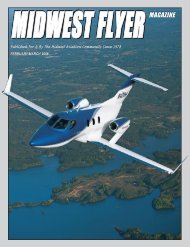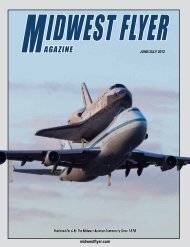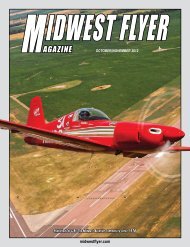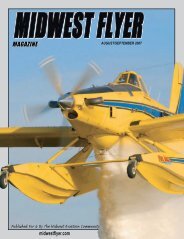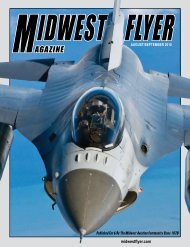minnesota - Midwest Flyer
minnesota - Midwest Flyer
minnesota - Midwest Flyer
Create successful ePaper yourself
Turn your PDF publications into a flip-book with our unique Google optimized e-Paper software.
for the flamingos at<br />
the top of the hill,” he<br />
“Look<br />
said. I was in a speck of a<br />
town called Fisk, Wisconsin. I turned<br />
right, drove past the near-empty parking<br />
lot of the town’s lone tavern and<br />
looked for flamingos at the top of the<br />
hill. I saw them; they were hard to<br />
miss. Five men in pink shirts – so<br />
bright you could see them a million<br />
miles away, gathered in front of a<br />
trailer and holding the largest binoculars<br />
I’ve ever seen. These were the<br />
“Men of Fisk,” air traffic controllers<br />
for flights approaching Oshkosh,<br />
Wisconsin during the week of EAA’s<br />
AirVenture.<br />
Flying In<br />
Fisk, a town located approximately<br />
8 miles southwest of Oshkosh, was<br />
the required entry point for all airplanes<br />
flying VFR to the greatest airshow<br />
on earth. From everywhere in<br />
the country, pilots found their way to<br />
Ripon, Wis. and followed the railroad<br />
tracks to Fisk. Pilotage doesn’t get<br />
any easier than that. The organizers<br />
even laid large pink arrows alongside<br />
the tracks to help pilots confirm that<br />
they’re following the right path, going<br />
in the right direction.<br />
The Men of Fisk watched the line<br />
of arrivals. All planes were expected<br />
to be at 1,800 feet MSL and 90 knots<br />
or at 2,300 feet and 135 knots. With<br />
almost comically large binoculars,<br />
each plane was identified by the controllers<br />
and directed toward the landing<br />
runway that was nearest the parking<br />
for that plane type. Antique and<br />
classic aircraft were parked at one<br />
corner of the field, and “spam cans,”<br />
Cessna 172s, Piper Cherokees, etc.<br />
were parked at another, and so on.<br />
“Debonair over tracks at Fisk, follow<br />
the railroad tracks northeast out<br />
of Fisk to enter a right downwind for<br />
Runway 27, over the gravel pit located<br />
half-mile north of airport. Maintain<br />
24 MIDWEST FLYER MAGAZINE OCTOBER/NOVEMBER 2007<br />
EAA AIRVENTURE - OSHKOSH<br />
Flamingo Watching At EAA Is Sport Aviation<br />
by Karen Workman<br />
one thousand, eight hundred feet.”<br />
Communication was almost solely<br />
one way from the controllers. Pilots<br />
were to listen and silently comply.<br />
Occasionally a plane was asked to<br />
rock its wings, but only when there<br />
was confusion. Controllers could tell<br />
if the plane understood its assignment<br />
by watching its flight path. They also<br />
had to be alert to the infrequent plane<br />
further down the line that wanted to<br />
follow the assignment directed to an<br />
aircraft ahead of it, and get everyone<br />
marching in line again.<br />
On The Hill<br />
A white trailer sat at the top of a<br />
small grassy hill with numerous tall<br />
antennas surrounding it, a wooden<br />
deck on which a folding table decorated<br />
with duct-tape and loose papers<br />
was set up, and a portable metal storage<br />
bin that contained electronic<br />
equipment, a myriad of wires, and a<br />
large beige telephone. When the telephone<br />
rang, the nearest controller<br />
quickly reached into the bin to answer<br />
it. It was a call from the tower to let<br />
the Men of Fisk know changes to the<br />
runway usage. Tower might say that<br />
Runway 36 is now for departures<br />
only, and all arrivals should be directed<br />
to Runway 27.<br />
The tower was required to accept<br />
arrivals sent to it by the controllers at<br />
Fisk and coordinate them with departures.<br />
“How goes Fisk, so goes the<br />
tower,” was their catch phrase. When<br />
tower became overwhelmed with traffic,<br />
Fisk would be asked to start holding<br />
planes. The first aircraft that could<br />
be easily and positively identified<br />
would be directed to circle around an<br />
oval lake located approximately 7<br />
miles southwest of Fisk. That plane<br />
would be watched as the lead and<br />
subsequent arrivals would be sent to<br />
follow it around and around. When<br />
tower determined the hold was no<br />
longer needed, Fisk would receive<br />
another phone call. The lead plane<br />
would then be directed out of the<br />
holding pattern and put on course for<br />
arrival at Oshkosh.<br />
The Team<br />
The Men of Fisk milled around the<br />
deck, sometimes sitting at the table,<br />
sometimes standing to stretch or to<br />
get a better look at the sky. Their<br />
eight-hour shift began at six o’clock<br />
that morning and they had only a few<br />
hours left in their duty day. They<br />
would have the afternoon and evening<br />
off. The next day, they would no<br />
longer be the Men of Fisk. They<br />
would wake up as the “Fly-By Mobile<br />
Team” on Runway 18-36.<br />
Air traffic control at Oshkosh during<br />
AirVenture is managed by small<br />
teams committed to safely guiding the<br />
visiting planes. These teams consist of<br />
an elite group of highly experienced<br />
controllers from around the country.<br />
For more than a week each summer,<br />
Oshkosh is the busiest airport in the<br />
world. To keep it safe, only the best<br />
of the best are chosen to control the<br />
traffic.<br />
Preparation<br />
Every February, interested controllers<br />
submit a bid to work at the<br />
event. Selections are announced in the<br />
spring and 15 teams are assigned.<br />
Each team would ideally have a lead,<br />
a veteran, a limited and a rookie. The<br />
“lead” would be an air traffic controller<br />
with many AirVenture shows<br />
under his/her belt, who had also<br />
demonstrated their ability to supervise<br />
effectively. The “veteran” would have<br />
worked at least two previous years at<br />
AirVenture. The “limited” would have<br />
worked one year before. And then<br />
there's the “rookie,” the new kid on<br />
the block. This person made the cut to<br />
work in the intense environment of<br />
AirVenture, but hadn't yet gotten<br />
his/her feet wet.



